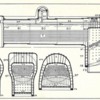During a recent visit to the Illinois Railway Museum, my wife asked my why steam engines had so many rivets on certain parts of them. I honestly didn't know. Can anyone help me out here?
For example, this engine has a ton of rivets in clusters right before the cab:
And a couple of detail shots from other engines:
I'm guessing these are above the firebox. I have a hard time believing this would be part of the boiler since the more you put hole in the side wall the more likely it would be to rupture. Of course, I could be wrong.
So what are these attached to?
Thanks!













